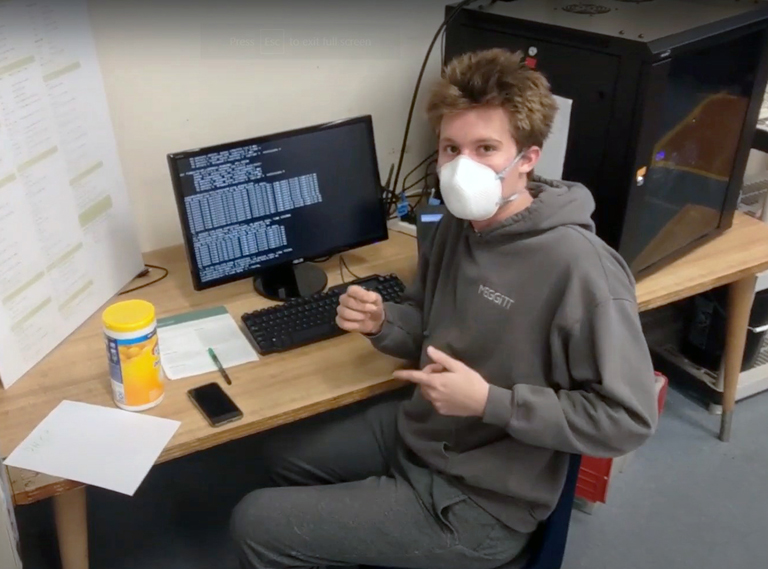
Crescenta Valley High School student Lukas Fullner, seen here during a vlog with his teacher Dr. Greg Neat and classmates, introduced Folding@home to his class and through his efforts they are helping to fight COVID-19.
By Charly SHELTON
According to the Global Digital Reports from HootSuite, 57% of the world’s population is connected to the Internet. The average Internet user now spends more than six and a half hours online each day. That leaves nearly 18 hours, on average, that the personal computer is not being used for gathering or distributing data from the Internet. One student at Crescenta Valley High School has volunteered his computer to do work for the good of the world – while he’s not using it for homework.
“A lot of diseases, viruses like the coronavirus, operate in certain ways,” said Lukas Fullner, a student in the Advanced Placement computer programming class at Crescenta Valley High School, in a vlog sent to the class by teacher Dr. Greg Neat. “Coronavirus interacts with your body in a certain way and, if we can figure out how that works, we can then do things to stop it from interacting in that way and make it have [fewer] effects or even stop it. But we can’t just look at it and see what it does. We have to use these complex computer programs to model what it does and those are really computer intensive. So what Folding@home does is split [the larger computations] into jobs and sends them to every participating computer, which can then do the math and send them back. Basically it helps these scientists set the models, which they can use to cure the disease.”
Folding is a distributed computing system that allows scientists to submit proteins to be folded by computers with spare power, Fullner told CV Weekly. This uses the computer’s processing power and Internet connection to do thousands upon thousands of mini-computations, which help predict models of interaction between the virus and host. Just like Iron Man has done so many times in the Marvel films, it all comes down to locking a model of prediction before knowing if this new suit will run or being able to track the villain; however in this case the villain is a real virus that needs a vaccine. By modeling the problem based on data collected through Stanford University, the network of participating computers works as one massive computer to make the overall problem-solving quicker and more efficient.
“We have a server that is basically like Dropbox. I wanted the kids to know what the cloud was and so in my room we actually have a server that can provide those functions that you can do with AWS [Amazon Web Services] or with Dropbox or whatever,” Dr. Neat said. “When we went into remote [learning due to the COVID-19 shutdown] we needed to make [the server] accessible from the outside because before remote you could only use [the server] if you were in the classroom.”
Fullner was helping Dr. Neat make the server accessible to remote learners when he told him that he built a computer at his house “just for fun” once remote learning was put into place.
“He told me about the Folding@home thing and that he was using his computer to do that,” said Dr. Neat. “Then I got all excited because the server is great at doing that kind of work. I mean that’s what that Folding@home thing is all about –getting these idle powerhouses to just crunch away at the scientist stuff.”
For anyone with a computer that is willing to help the Folding@home team from CVHS, the process is simple and free. By visiting the website, FoldingAtHome.org, and installing the client, your computer can help cure COVID-19.
“Once a user installs the client, the Folding@home server will send them jobs automatically and once they are completed the jobs are sent back. The client is fully automated and will run on its own,” Fullner said. “The public can join by downloading the client, and when prompted can join the CVFolding team by entering the team number 260,292.”
The CVFolding team, consisting of 13 CPUs is, at press time, ranked 5,298 of 254,107, or in the top 2% in the world.
Dr. Neat is very proud of his student and his whole class that has taken on the challenge to make positive change in the world.
“Lukas is an example of somebody who’s bursting with passion. Everything we saw him do was on his own initiative,” Dr. Neat said in his vlog to the class. “He wasn’t doing it for credit, I didn’t ask him to do it, it was him pursuing something he loved and applying it to a problem that the world needs [solved] right now. And that’s just beautiful. I was thinking if I still worked at JPL right now I would hire him in a second.”
To see Dr. Neat’s vlog when Lukas introduced the concept and prepared the in-class server for external communications and for the CVFolding team, visit https://bit.ly/3fNtoF4.
